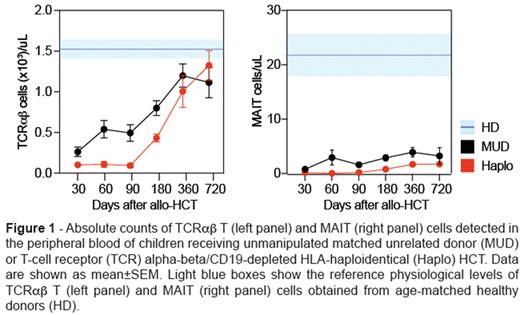Abstract
Delayed quantitative and qualitative immune recovery, in particular of the T-cell lineage, is associated with an increased risk of infections, disease relapse and adverse clinical outcomes in patients receiving allogeneic hematopoietic cell transplantation (allo-HCT). This delay is particularly relevant for recipients of T cell-depleted grafts who do not benefit from the adoptive transfer of mature donor T cells and experienced profound and prolonged immunodeficiency which lasts until the T-cell pool is newly generated from donor hematopoietic precursor cells. A better understanding of the reconstitution dynamics of all the components of the immune system after allo-HCT is crucial to optimize the control of infections, leukemia relapse and graft-versus-host disease (GvHD).
We performed a longitudinal observational study to explore the kinetics of T-cell recovery in patient peripheral blood by combining multiparameter flow-cytometry and functional ex vivo assays. Ninety-three children with hematological malignancies who received transplantation after myeloablative conditioning regimen were included in the study: 59 patients received T-cell receptor (TCR) alpha-beta/CD19-depleted HLA-haploidentical HCT (alpha/beta-haploHCT), while 34 unmanipulated matched unrelated donor (MUD) HCT (32 MUD recipients received BM and 2 received PBSC).
Among the different T-cell populations assessed, we found that mucosal-associated invariant T (MAIT) cells displayed profound alterations in frequency and function across all time points analyzed. MAIT cells are a class of unconventional αβ T cells that recognize microbial proteins presented by non-polymorphic MHC class I related-molecule (MR1) and possess innate-like capacity. While total TCRαβ T cells gradually started to recover approximately from 3 months reaching normal levels between one to two years post transplantation (Figure 1), MAIT cells defined as CD3+ TCRαβ+ MR1-5-OP-RU-tetramer+ showed long-term impaired reconstitution, and their numbers did not reach normal levels up to two-years post-HCT (Figure 1). Compared to MUD HCT, MAIT cell recovery after alpha/beta-haploHCT was significantly delayed, in agreement with the fact that TCRab reconstitution in this clinical setting is primarily driven by de novo T cell formation. Previous studies demonstrated that MAIT cells are characterized by the binding to MR1-Ag tetramers and simultaneous expression of the C-type lectin-like receptor CD161, a marker associated with memory phenotype and trafficking of immune cells. Interestingly, across all time points of the study, we observed that most MAIT cells following were CD161-. We also found increased expression of the activation marker CD38 and the senescence marker CD57, and downregulation of CD28 in MAIT cells following allo-HCT, suggesting a dysfunctional or hyperactivated status. In agreement with these data, ex vivo stimulation of PBMCs at day +360 post allo-HCT with Escherichia Coli or anti-CD3/anti-CD28 showed that MAIT cells had suboptimal upregulation of the activation markers CD25 and CD69, and reduced production of pro-inflammatory cytokines IFNg, TNFa and IL2, when compared to healthy control samples. Previous studies suggested that a low MAIT cell number was associated with an increased risk of acute GvHD, In the MUD cohort of our study, we did not observe significant correlations between the kinetics of MAIT cell recovery and the occurrence of GvHD. On the other hand, we found a significantly higher frequency of CD161+ MAIT cells at day +30 in alpha/beta-haploHCT patients who developed acute GvHD (grade 1 or greater). Trends toward higher frequency of CD161+ MAIT cells in patients developing acute GvHD were also observed at day +60 and +90, although not statistically significant.
Our study shows that MAIT cell recovery is delayed in children for up to two years following allo-HCT. MAIT cells exhibited altered functional status as demonstrated by the expression of activation/senescence makers as well as the suboptimal response to TCR stimulation. Interestingly, we found that a large proportion of MAIT cells are CD161- after transplantation, which can be the result of recruitment of CD161+ cells to peripheral tissues or down regulation of CD161 after cell activation. Finally, our data suggested that the evaluation of CD161 expression on MAIT cells after alpha/beta-haploHCT may identify patients at risk of acute GvHD.
Disclosures
Locatelli:AMGEN: Membership on an entity's Board of Directors or advisory committees, Speakers Bureau; NEOVII: Membership on an entity's Board of Directors or advisory committees, Speakers Bureau; NOVARTIS: Membership on an entity's Board of Directors or advisory committees, Speakers Bureau; SANOFI: Membership on an entity's Board of Directors or advisory committees; MILTENYI: Membership on an entity's Board of Directors or advisory committees, Speakers Bureau; MEDAC: Speakers Bureau; GILEAD: Speakers Bureau; TAKEDA: Speakers Bureau; BLUEBIRD BIO: Speakers Bureau; SOBI: Speakers Bureau; JAZZ PHARMACEUTICALS: Speakers Bureau; PFIZER: Membership on an entity's Board of Directors or advisory committees.
Author notes
Asterisk with author names denotes non-ASH members.


This feature is available to Subscribers Only
Sign In or Create an Account Close Modal